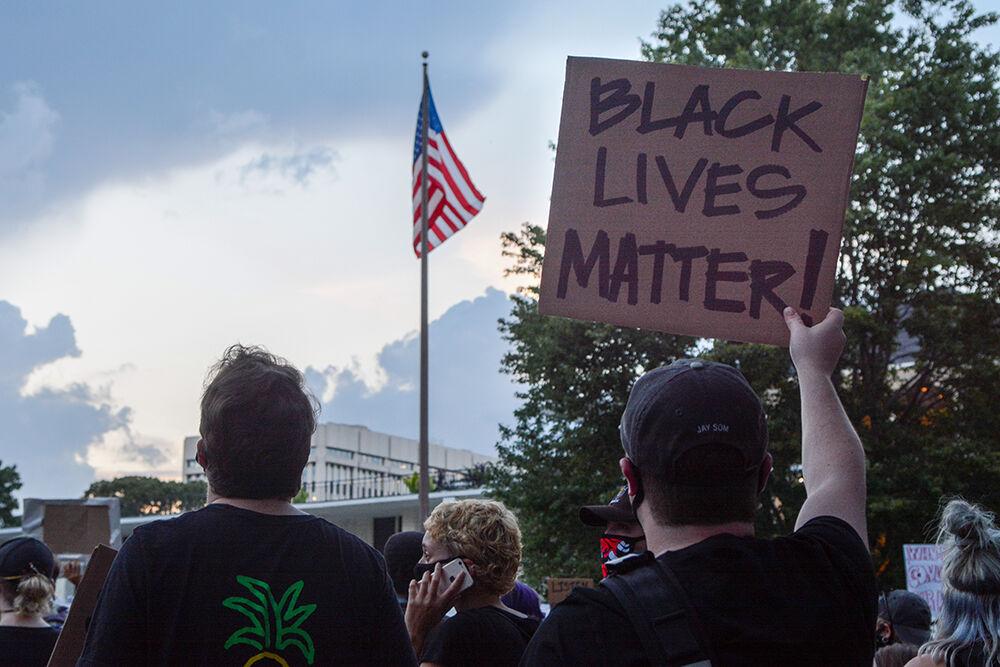On Aug. 28 and 29, in the wake of the shooting of Jacob Blake, a Black man, protesters marched in downtown Raleigh to protest the shooting of Blake and other Black Americans who have been injured or killed at the hands of police.
August 28th
On Friday Aug. 28, the day after Raleigh Mayor Mary-Ann Baldwin imposed a citywide 10 p.m. curfew for Friday and Saturday, protesters met at the steps of the Wake County Courthouse at 7 p.m.
Bryant E. Riddrick II, an activist and the founder of the Student Non-Violent Committee for Change 2020, and other activists spoke to approximately 1,000 protesters before the group moved down Fayetteville Street. During the march, protesters stopped at the State Capitol, governor’s mansion and the North Carolina Legislative Building.
Many NC State students were in attendance at the march on both days, such as Max Crownover, a fifth-year studying political science and history. Crownover said he thought the protests would remain peaceful over the weekend.
At approximately 7:40 p.m., protesters marched up to the barricade of the North Carolina Legislative Building and burned an American flag. By 8 p.m., the protesters returned to the Wake County Courthouse and protest leaders spoke in front of the crowd.
Riddrick left the protests shortly after 8 p.m.
Multiple protesters at the event were not aware of what organization planned the protest. According to a memo released by Raleigh Police Chief Cassandra Deck-Brown, the protests are believed to be organized by North Carolina Building Our Revolution Now and Smash Racism Raleigh.
According to WRAL, at 9:20 p.m., protesters toppled barricades and port-a-potties, started fires and lit fireworks. At 9:30 p.m., protesters spray-painted the side of the Wake County Sheriff’s Office and smashed the window of the Wake County Justice Center. At 9:45 p.m., protesters spray-painted Wake County’s memorial for fallen deputies.
At 10 p.m., law enforcement used an intercom device to attempt to disperse the crowd in response to protestors staying out past the issued curfew time. Protesters continued to set off fireworks, throw water bottles until around 11 p.m., when the Raleigh Police Department began to make arrests.
WRAL reported that Raleigh police arrested 14 people for not complying with the 10 p.m. curfew, and one arrest was made for assault on a law enforcement officer. Two of those arrested were lawyers with the National Lawyers Guild.
August 29th
On Saturday, in the late afternoon, approximately 70 protesters marched in downtown Raleigh for the second day in a row. They marched from Fayetteville Street to the governor’s mansion, crossing through the State Capitol grounds on their way, before marching back. At 4 p.m., clergy, police and city leaders held a prayer vigil for unity, equality, and social equity in Moore Square.
Vigil leaders, including the Shaw University School of Divinity, the city of Raleigh and Shop Local Raleigh, asked Raleigh residents to step outside at 9 p.m. and shine a light for unity and peace in the community. According to WRAL, no arrests were made Saturday night due to the protests.
Law enforcement outnumbered protesters, and the Salisbury Street block between West Martin Street and West Davie Street was blocked off. Police officers surrounded the Wake County Sheriff’s Office, the Wake County Courthouse and the Wake County Justice Center. The officers also had an armored rescue vehicle parked on Salisbury Street by 7:30 p.m.
Windows at businesses on Fayetteville Street and surrounding areas were boarded up, and many had hopeful messages written by protesters and artists. There were no reported damages by any businesses this weekend, according to WRAL.
The police department did not deploy tear gas or rubber bullets against protesters Friday or Saturday, unlike in May during the protests that occured in the wake of George Floyd’s death.
Baldwin said she credits the curfew and proactive response to the reduced damages that occurred. Not only was a curfew put in place, but streets were closed and businesses were encouraged to prepare.
According to the memo released by Decker-Brown, preparations included removing outside furniture and other potentially unsafe items, as well as removing or concealing any vaubles, making sure points of entry were secure and enabling security cameras and alarms. Law enforcement was also not in full riot gear.
August 30th
At 11:46 a.m. Sunday morning, Baldwin rescinded the curfew put in place. She stated in her news release that “While a small number sought to cause distractions—and were held accountable—the message of reform and justice is not lost or overlooked.”








